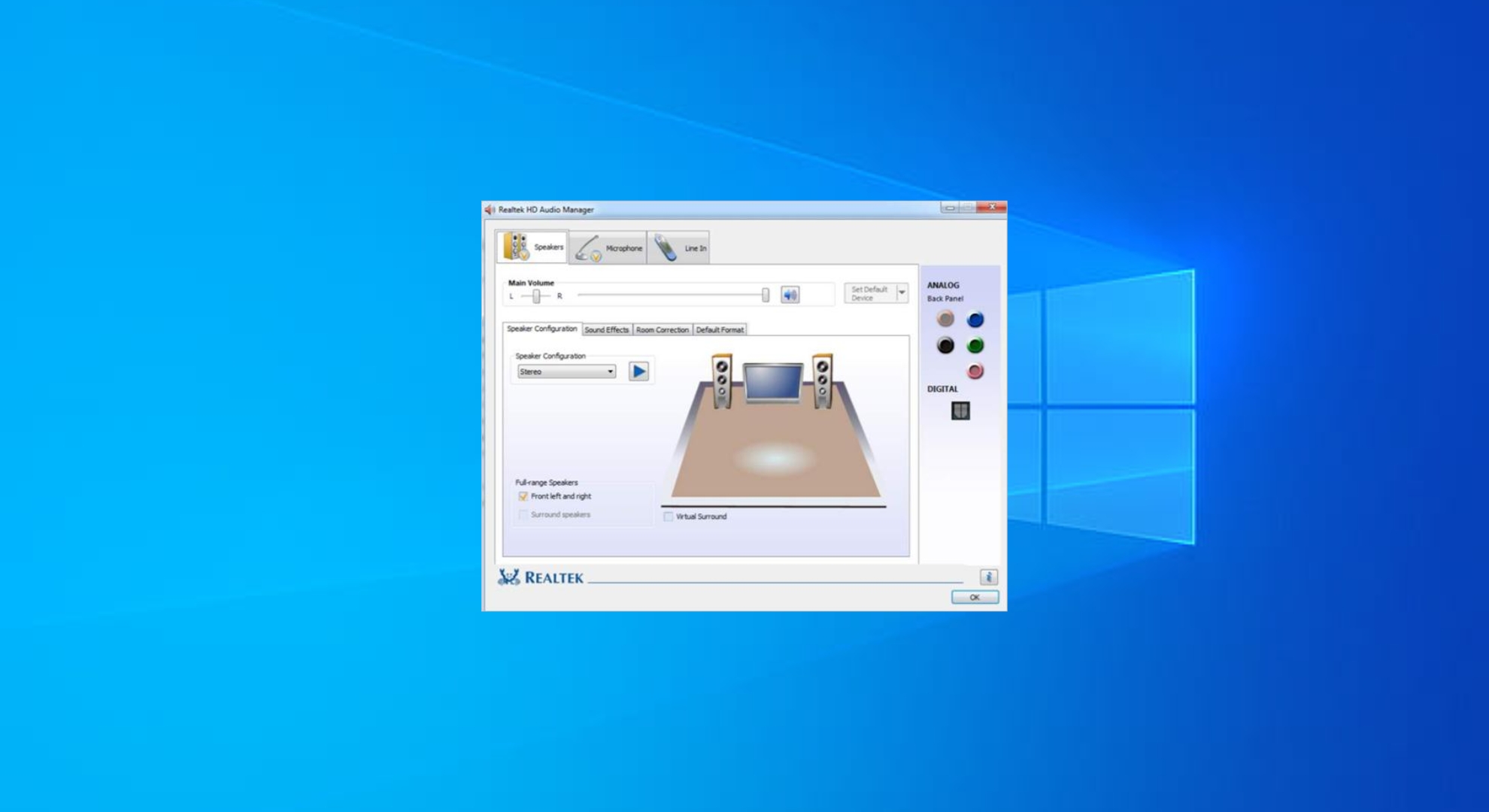What is Realtek? How to Fix Common Issues with Realtek in 2024
- Realtek drivers are essential for optimal functionality of your computer's audio systems, managing everything from sound output to microphone input.
- Common audio issues related to Realtek drivers can often be resolved through simple steps like updating drivers, turning off audio enhancements, and ensuring correct service settings.
- Always download Realtek driver updates from official sources such as the Realtek website or your hardware manufacturer's support page to maintain system security and functionality.
Realtek is not just another tech company. It’s an important player in the semiconductor industry, deeply rooted in countless computing systems worldwide. This company specializes in various ICs (integrated circuits) that power critical functions in laptops, desktops, and more.
The significance of Realtek extends beyond just supplying chips. It shapes how we experience technology. From the sound that fills our room from a speaker to maintaining stable internet connections, Realtek’s innovations make modern computing more accessible and reliable.
This guide will discuss what Realtek is, uncover how its technologies influence our digital experiences, and highlight the common issues with Realtek HD audio drivers.
Table of Contents
What is Realtek?

Realtek is a prominent semiconductor company known for designing and producing a wide range of integrated circuits (ICs), essential components in various electronic devices. Based in Taiwan, Realtek has carried out a niche in the global tech market, particularly in computer and network technology.
The company is best known for its audio and network chips. Realtek’s audio chips are widely used in computers, providing the necessary technology for sound generation. Whether it’s the sound from a computer’s speakers or headphones, there’s a good chance a Realtek audio codec powers it.
In addition to audio solutions, Realtek is one of the major providers of network chips, including Ethernet controllers and wireless network chips. They also develop controllers for displays, card readers, and other accessories, demonstrating their versatility in the tech industry. Their commitment to innovation helps enhance user experience across various platforms and devices.
READ MORE: How to Install Realtek Microphone Drivers ➜
How did Realtek software end up on your computer?

Realtek drivers, particularly the Realtek HD Audio Manager, are commonly found on many computers because Realtek’s audio chips are extensively used in various PC systems. Buying a new computer, especially one with Windows operating system, often comes with installed Realtek audio components.
Windows and many hardware manufacturers choose Realtek for their reliable and high-quality audio solutions.
When Windows is installed on a computer, it automatically detects the hardware components and installs the necessary drivers to ensure that everything works seamlessly from the start. Since Realtek’s audio chips are widely used, Windows includes drivers in its installations.
This means the Realtek HD Audio Manager software often comes pre-installed, ready to help you manage audio settings and improve your sound experience immediately.
READ MORE: How to Find Out How Old Is Your Computer – Windows & Mac ➜
Common issues with the Realtek HD audio tool
The Realtek HD Audio tool is widely used but not without its issues. Many users often wonder why their systems come pre-installed with Realtek software and what causes their everyday problems. Here are some frequent issues with the Realtek HD Audio tool:
- Audio Distortion: Users report crackling or distorted sound, which can disrupt audio playback quality.
- Driver Conflicts: Realtek’s drivers can conflict with Microsoft’s native drivers, causing system instability or performance hiccups.
- Automatic Installation: Realtek drivers are often automatically installed with system updates, which can frustrate users who prefer other audio solutions.
- Missing Audio Manager Icon: After updates, the Realtek HD Audio Manager icon may disappear from the system tray, leaving users without quick access to audio settings.
- Incompatibility with Updates: Windows updates can sometimes lead to incompatibilities with Realtek drivers, resulting in audio issues or the audio device disappearing.
READ MORE: How to Fix Install Realtek HD Audio Driver Failure ➜
How to fix common issues with Realtek audio?
Fixing common issues with Realtek audio usually involves simple troubleshooting steps. Start by ensuring your speaker connections are secure and the audio is not muted or too low. Here are some quick fixes that you can try:
1. Update Realtek HD audio drivers
Updating your Realtek audio drivers through Windows Device Manager is a straightforward process that ensures your audio hardware communicates effectively with your operating system. Here are the steps to follow:
- Press the “Windows key + R,” type “devmgmt. msc“, and press “OK” to open Device Manager.

Open Device manager - Scroll down to find the “Sound, Video, and Game Controllers” category and expand it.

Open Sound devices tab - Right-click on “Realtek Audio” or a similar name, depending on your system.

Click on Realtek Audio - Select the “Driver tab” and click on “Update driver.”

Click on Update Driver - Choose “Search automatically for drivers.” Windows will search online for the latest drivers and install them automatically.

Click Search automatically for drivers
Once the installation is complete, restart your computer to ensure the updates take effect properly.
READ MORE: How to stop ‘Windows 10 installing Realtek Drivers automatically’ ➜
2. Disable Audio Enhancements
Audio enhancements are designed to improve sound quality, but they can sometimes conflict with your system settings or audio hardware, causing issues like distorted sound or no sound. Disabling these enhancements can help stabilize audio playback and resolve such problems. Here’s how to turn them off:
- Right-click the sound icon in the system tray and select “Sounds.”

Click Sounds - Go to the “Playback” tab, right-click your default device (usually Realtek High Definition Audio), and select “Properties.

Click on Properties - Navigate to the “Enhancements” tab.

Open Enhancement Tab - Check the box next to “Disable all enhancements” or “Disable all sound effects.”

Disable all enhancements - Click “Apply” then “OK” to save the changes and close the window.

Click OK
3. Enable/Restart Windows Audio Service
The Windows Audio Service is crucial for sound output on your computer. If this service is stopped or malfunctioning, it can lead to no sound issues. Ensuring this service is active and set to start automatically can resolve these problems. Here’s how to manage the Windows Audio service:
- Press Windows + R to open the run dialog, type “services.msc” and click “OK” to open the Services window.

Click OK to open Services - Scroll down and find “Windows Audio” in the list.

Find Windows Audio - Right-click on “Windows Audio” and select “Properties“.

Click on Properties - In the “Properties” window, set the Startup type to “Automatic.”

Click on Automatic - If the service is not running, click “Start” to begin the service. If it is already running, click “Stop” and then “Start” to restart it.

Click Start - Click “Apply” and then “OK” to save your settings.

Click OK
READ MORE: How to Fix Audio Services Not Responding Windows 10/11 ➜
4. Change the default sound format
Incorrect sound format settings can lead to poor audio quality or no sound at all. Adjusting the sound format to match your speaker configuration can enhance audio performance. Here’s how to change the default sound format:
- Right-click the “Sound” icon in the system tray and select “Sounds“.

Click on Sounds - Go to the “Playback” tab, right-click your default playback device, and choose “Properties.

Click on Properties - In the “Properties” window, navigate to the “Advanced” tab.

Click Advanced - Under “Default Format,” select a different sample rate and bit depth from the dropdown menu. For example, choose 24-bit, 44100 Hz (Studio Quality) for high-quality audio output.

Change the default format - Click “Apply” then “OK” to save the changes and exit.

Click OK
5. Check for Windows Updates
Driver compatibility issues can often be resolved by updating Windows, as updates may include new or improved drivers and bug fixes that enhance system performance and stability. Here’s how to check for and install Windows updates:
- Press Windows + I to open “Settings” and navigate to “Update & Security.”

Open Update & Security section - Click “Windows Update“, then click “Check for updates.”

Click on Check for Updates - If updates are available, select “Download and Install.” This might include updates for Realtek audio or other system components.

Install if any update is available
Restart your computer after the updates are installed to ensure all changes take effect.
READ MORE: How to Clear Windows Update Cache in 7 Steps [2024] ➜
Final thoughts
Addressing common issues with Realtek audio on your computer can significantly enhance your audio experience. By following the steps outlined—such as updating Realtek High-Definition Audio drivers, disabling audio enhancements, ensuring the Windows Audio service is active, and adjusting sound settings—you can often solve most audio playback problems.
Disabling conflicting audio drivers and keeping your system up-to-date with the latest Windows updates can prevent future issues. Each solution helps resolve specific problems and optimizes your system’s audio performance, ensuring you get the best sound quality for entertainment and communication.
FAQs
To reset your Realtek audio settings to their original state, open Realtek HD Audio Manager, navigate to the sound effects tab, and click the “Default” button. This will revert all custom settings to the factory defaults.
Yes, Realtek drivers include settings that can influence the output (speakers/headphones) and input (microphone) audio. Adjustments in the Realtek HD Audio Manager can affect microphone boost, noise suppression, and acoustic echo cancellation, thereby impacting overall microphone quality.
To ensure security and compatibility, it’s safest to download Realtek audio drivers from the official Realtek website or your PC or motherboard manufacturer’s support page. Downloading drivers from third-party sites can expose your computer to security risks like viruses and malware.
Realtek HD Audio Manager is designed to control internal Realtek audio chips embedded in motherboards. It does not support external sound cards, which generally come with their own audio management software provided by the respective manufacturer.
 Reviewed by
Reviewed by 




